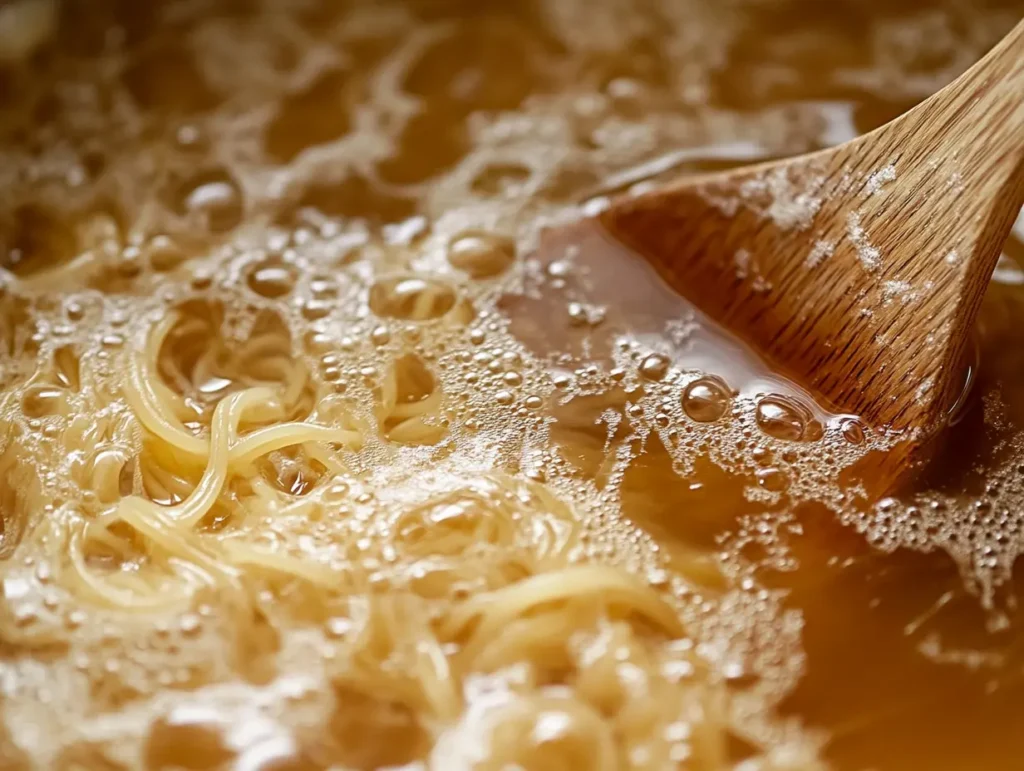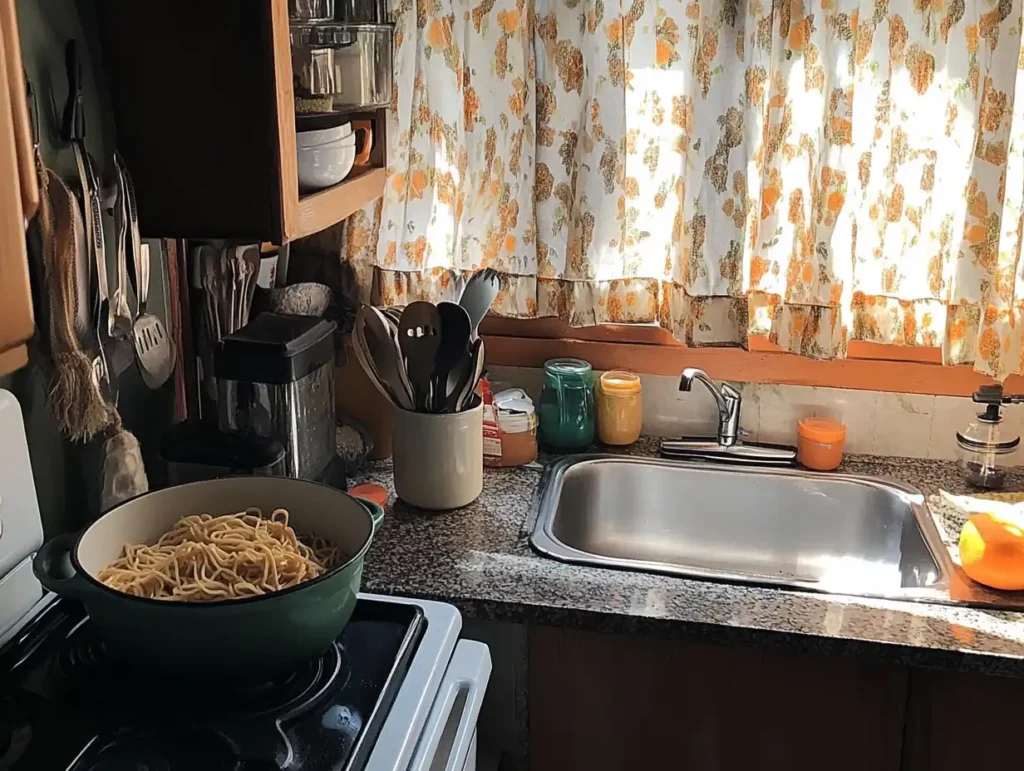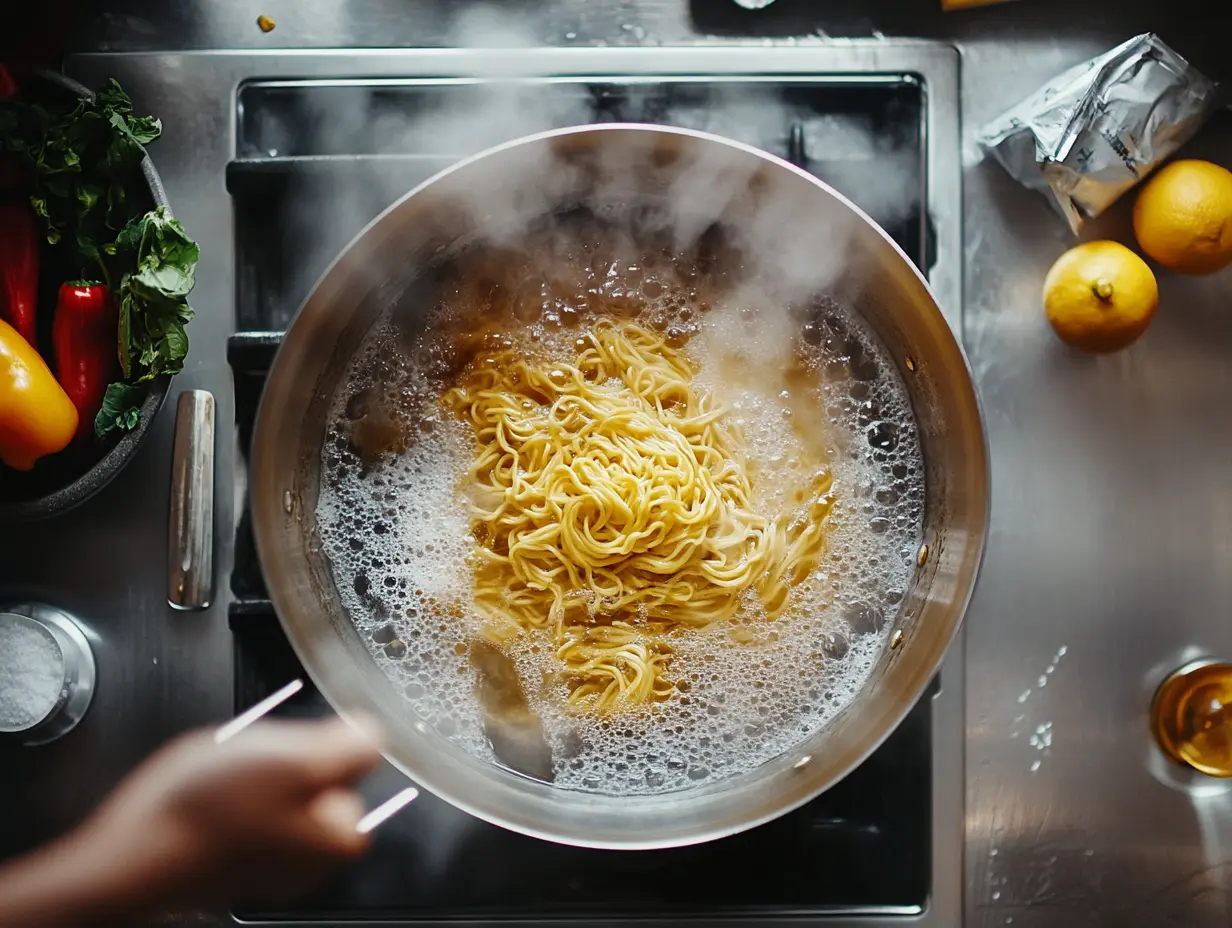Discover the ideal water-to-noodle ratio, cooking tips, and flavor tricks to achieve perfectly cooked noodles every time.
Table of contents
How much water for 2 cups of noodles is a question many home cooks often ask. Essentially, understanding the correct water amount ensures perfect texture and flavor. Indeed, if you add too little water, your noodles may stick together. Conversely, if you add too much water, you risk diluting flavors and wasting time waiting for the pot to boil. Altogether, a balanced ratio leads to a delightful meal. Basically, this article delves into the factors influencing noodle preparation, and afterward, it offers practical tips, recipes, and troubleshooting advice.
How much water do I need for 2 cups of noodles — The Basics
When approaching this question, it is essential to clarify what “2 cups of noodles” means. Typically, 2 cups refer to the uncooked volume. Generally, dried noodles expand significantly once cooked. Because of that, you need sufficient liquid to allow them to move freely and cook evenly. Accordingly, most cooking experts suggest starting with about 4 to 6 cups of water for every 2 cups of dry noodles. Basically, a simple rule of thumb states you should use around three times more water than the volume of dry noodles.
Comparatively, using more water ensures that starch disperses evenly. Consequently, your noodles come out tender rather than gummy. Especially when dealing with standard pasta shapes—like spaghetti, penne, or fusilli—the recommended ratio holds true. Undoubtedly, measuring this water precisely leads to consistent results and better-tasting dishes every time.
Measuring Volume Accurately
Accurately measuring both your noodles and water is vital. How Much Water for 2 Cups of Noodles? This is a common question, and getting it right ensures consistency and perfectly cooked pasta. Indeed, if you rely on guesswork, you risk inconsistency in texture and taste. Therefore, use a reliable measuring cup for both water and noodles.
Initially, measure your noodles dry to determine the correct portion. Afterward, transfer them to your cooking pot. Next, measure your water using standard cups or a kitchen scale that measures fluid ounces. Understanding how much water for 2 cups of noodles is key to avoiding sticky or undercooked results. Eventually, you will develop an intuitive sense of the ideal water ratio, but careful measurement is the best starting point.
How much water do I need for 2 cups of noodles If Using an Electric Kettle
Sometimes, you may boil water in an electric kettle before pouring it into your pot. How Much Water for 2 Cups of Noodles? The process can be sped up using preheated water, but the ratio remains similar. Specifically, aim for about 4 to 6 cups of water per 2 cups of noodles to ensure they cook evenly. However, keep in mind that preheated water might evaporate faster. How Much Water for 2 Cups of Noodles? Always ensure your pot is covered to maintain proper levels and prevent unnecessary loss during cooking.
Adjusting for Different Cooking Methods
While stovetop cooking is the norm, some might use induction burners, hot plates, or even microwaves. How Much Water for 2 Cups of Noodles? The ratio remains consistent regardless of the cooking method. However, be mindful that weaker heat sources may require a tad more water to maintain a steady boil. Afterward, as you experiment with different methods, adjust the quantity slightly to ensure the noodles remain fully submerged until they reach the desired tenderness. This way, you’ll always achieve perfect results, no matter the setup.
Understanding Water-to-Noodle Ratios
Noodles are not all identical. For example, thin noodles like angel hair require less time and can manage with slightly less water. Conversely, thicker noodles, such as linguine or udon, benefit from more water. Furthermore, some noodles release more starch, thickening the water. Consequently, starting with a generous amount of water prevents stickiness and fosters even cooking.
Basically, water-to-noodle ratio influences texture, flavor extraction from salted water, and cooking time. Indeed, the right ratio allows noodles to float freely, absorbing just enough moisture for a perfect bite. Likewise, it ensures that the starches do not concentrate excessively, which can cause clumping and an unpleasant mouthfeel.
Factors Affecting Water Quantity
Many factors influence how much water do I need for 2 cups of noodles beyond the simple ratio. Chiefly, your pot size matters. A large, wide pot allows water to heat quickly and evaporate more. Consequently, you might need slightly more water to compensate for evaporation. Meanwhile, smaller pots may require less water but need closer attention to avoid boiling over.
Altitude also plays a role. Indeed, at higher elevations, water boils at a lower temperature. Therefore, you might need a bit more water to ensure thorough cooking since evaporation occurs more readily. Additionally, different noodle types—dried, fresh, gluten-free—absorb water differently. Eventually, you will refine your approach based on experience and taste preferences.
Achieving Optimal Texture
Proper water ratios help achieve that ideal al dente texture. Undoubtedly, enough water ensures noodles do not lump together, which can happen if they are too cramped. Furthermore, stirring occasionally prevents them from sticking to the pot’s bottom. Consequently, each strand or piece cooks uniformly. Especially when making pasta dishes that rely on texture, having the right amount of water is crucial.
Meanwhile, controlling heat levels contributes to optimal outcomes. Initially, bring the water to a rolling boil. Afterward, add the noodles and maintain a lively simmer. Because starch is released during cooking, generous water volume helps keep everything moving and prevents clumps. Thus, you get noodles with a delightful bite every time.
Mastering Cooking Techniques: How much water do I need for 2 cups of noodles in Different Pots

Choosing the right pot is not trivial. For 2 cups of noodles, a medium-sized pot might suffice. However, for larger shapes or more delicate noodles, consider a bigger pot. Altogether, a roomy pot ensures you have ample space and allows the water to circulate freely around the noodles.
A large stockpot is particularly beneficial for maintaining consistent heat and reducing foam. Conversely, using a small saucepan might mean you need to keep a closer eye on the boil. Eventually, practice will guide you toward the best tools. Indeed, the goal is to find what works for your kitchen and recipe.
Timing the Boil
Before adding noodles, ensure the water reaches a full boil. Initially, it might be tempting to toss noodles in early, but that can lead to uneven cooking. Consequently, wait until the water rolls vigorously. This approach ensures the noodles start cooking at a high temperature, delivering consistent results.
How much water do I need for 2 cups of noodles for Gluten-Free Options
Gluten-free noodles, made from corn, rice, or other non-wheat flours, may require slightly more attention. Undoubtedly, these noodles sometimes release more starch and can stick if water is insufficient. Therefore, try starting with about 6 cups of water for 2 cups of gluten-free noodles. Afterward, adjust according to your preferred brand’s instructions and personal experience.
Choosing the Right Tools
Selecting quality utensils, like a wooden spoon for stirring, ensures even distribution of heat and prevents sticking. Accordingly, a sturdy pot and well-fitting lid help maintain a steady simmer. Likewise, having a strainer on hand makes draining efficient. Meanwhile, using a timer keeps the process predictable and improves consistency.
Flavor and Seasoning Considerations
How Much Water for 2 Cups of Noodles? Your water is not just a cooking medium; it plays a crucial role in the flavor and texture of your dish. To ensure your noodles cook evenly and don’t clump together, using plenty of water is key. But how much water for 2 cups of noodles is ideal? Generally, about 4-6 cups of water is recommended for every 2 cups of noodles to allow enough space for the pasta to move freely as it cooks.
Don’t forget, water is also part of the flavor equation. Adding a pinch of salt enhances the noodles’ taste, making them more vibrant even before adding sauces. A teaspoon of olive oil can help prevent sticking, though it’s less critical when using ample water. For extra depth, consider adding aromatics like garlic, onion, or bay leaves to the boiling water. These subtle infusions elevate the noodles’ flavor, ensuring your dish starts with a flavorful base.
Perfect Flavor: How much water do I need for 2 cups of noodles With Broth Variations
Sometimes, water alone is not enough. Indeed, replacing some or all of the water with broth can impart richer flavor. Because broth often contains salt and seasonings, adjust your ratios and seasonings accordingly. Furthermore, thicker broths might require slightly less liquid to prevent the noodles from becoming overly soft.
Infusing Herbal Notes
Adding fresh herbs, like thyme or rosemary, to your cooking liquid can deliver subtle aromatic complexity. Generally, these herbs infuse flavors as the noodles cook. Consequently, this extra step elevates a simple dish into something memorable.
How much water do I need for 2 cups of noodles to Achieve Perfect Al Dente Texture
Al dente noodles have a tender yet firm bite. Indeed, controlling water ratio helps achieve this. If the water is insufficient, noodles might stick and overcook in patches. Conversely, too much water can dilute seasonings and extend cooking times unnecessarily. Therefore, aim for about 4 to 6 cups of water for 2 cups of noodles. Afterward, test a noodle for doneness a minute or two before the package’s suggested time.
Controlling Saltiness
When using salted broth, reduce additional salt. Consequently, you maintain a balanced flavor. Basically, taste the water before adding noodles. If it tastes pleasantly seasoned, you are on track.
Common Mistakes and Troubleshooting
Sometimes, despite best efforts, things go awry. Perhaps the noodles come out mushy. Undoubtedly, that might mean you cooked them too long or used too much water. Conversely, if they are too firm or clumping, maybe you did not add enough water. Generally, adjusting water volume, cooking time, and stirring frequency resolves these issues.
If you find the flavor lacking, add a pinch of salt or finish the dish with a drizzle of olive oil or grated cheese. Additionally, if noodles absorb all liquid too quickly, start with a bit more next time. Eventually, you will gain confidence and precision in your noodle-cooking skills.
Recipe: Perfectly Cooked 2 Cups of Noodles
Ingredients (for 2 cups dry noodles):
- 🍜 2 cups dry noodles (e.g., spaghetti, penne, or your favorite variety)
- 💧 4–6 cups of water (adjust slightly based on noodle type)
- 🧂 1 teaspoon salt (or to taste)
- 🥄 1 teaspoon olive oil (optional)
- 🌱 Handful of fresh herbs (e.g., basil, parsley) for garnish (optional)
Step-by-Step Instructions:
- Boil the Water:
Initially, fill a medium-sized pot with about 5 cups of water. Place it over high heat. Add the salt and cover the pot. Wait until the water reaches a rolling boil. - Add the Noodles:
Afterward, gently add your 2 cups of dry noodles to the boiling water. Stir them to prevent sticking. Keep the heat high until the water returns to a boil. - Maintain a Steady Simmer:
Once the boil resumes, reduce the heat slightly. Basically, you want a lively simmer that keeps the noodles moving. Stir occasionally to prevent clumps. - Test for Doneness:
About 2 minutes before the package’s suggested cooking time, take one noodle out and taste it. Consequently, if it’s too firm, wait a bit longer. If it’s almost at the perfect al dente, turn off the heat a little early, since carryover cooking will finish the process. - Drain and Serve:
Finally, once the noodles reach the desired texture, drain them using a strainer. Toss with olive oil if you like. Garnish with fresh herbs. Serve immediately with your favorite sauce or topping.
Variations:
- Add a cup of chicken or vegetable broth in place of some water for extra flavor.
- For gluten-free noodles, start with 6 cups of water and adjust as needed.
- Experiment with infused oils, like chili oil or garlic-infused oil, to add complexity.
Nutritional Information (per 100g cooked noodles)

| Nutrient | Amount |
|---|---|
| Calories | ~130 kcal |
| Carbohydrates | ~25 g |
| Protein | ~4 g |
| Fat | ~1 g |
| Fiber | ~1 g |
| Sodium | Varies (based on added salt) |
Basically, this table provides a rough estimate. Indeed, exact values depend on the specific noodle type and any added ingredients.
FAQs about How Much Water for 2 Cups of Noodles?
Q: Can I use less water to save time?
A: Yes, but use caution. Using too little water can make noodles stick together. Undoubtedly, starting with the recommended amount ensures even cooking and better texture.
Q: What if my noodles finish cooking before all the water evaporates?
A: That’s expected. You drain the excess water at the end. In fact, leftover cooking water is often reserved to adjust the consistency of sauces.
Q: Do I need to cover the pot?
A: Initially, cover it to help water boil faster. Once you add noodles, keep it partially uncovered to prevent boiling over and monitor doneness easily.
Q: Does altitude really matter?
A: Yes, at high elevations water boils at a lower temperature. Basically, you might need a bit more water and slightly longer cooking times for proper results.
Q: Can I reuse the cooking water?
A: Pasta water becomes starchy, which can help thicken sauces. However, for fresh cooking, start with fresh water to ensure consistent flavor and clarity.
Conclusion: How Much Water for 2 Cups of Noodles?
How much water do I need for 2 cups of noodles is a common culinary query that demands attention to detail. Basically, the ideal amount hovers around 4 to 6 cups, giving noodles ample space to cook evenly. Equally, adjusting for pot size, noodle type, and desired texture refines the process further. Indeed, simple steps like salting the water, timing the boil, and measuring accurately elevate a humble bowl of noodles into a flavorful, perfectly textured meal. Therefore, keep experimenting, trust your instincts, and enjoy the countless noodle dishes you can create.
